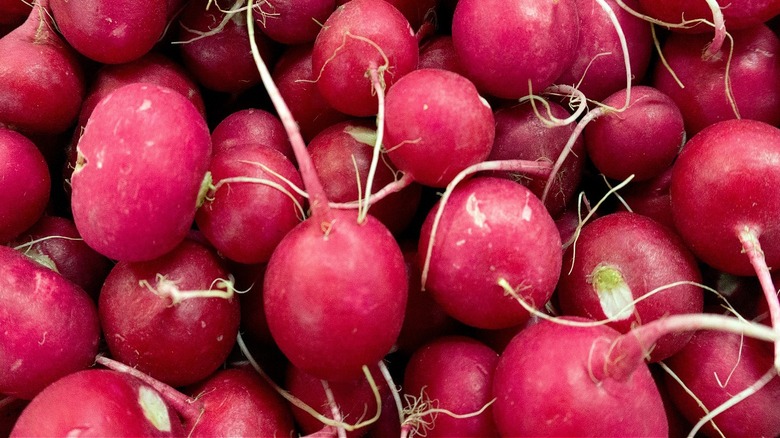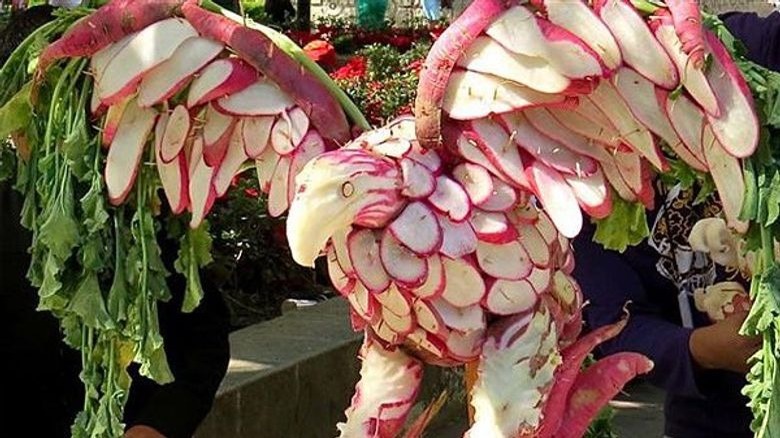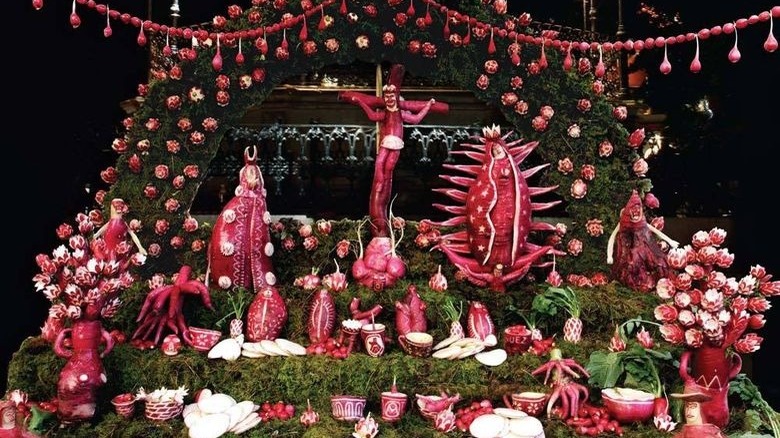The Mexican Festival That Pays Homage To The Radish
The humble radish doesn't typically receive a great deal of attention, but maybe it should. Whether you eat your radishes raw or cooked (yes, that's a real thing), they possess a flavor that is unlike anything else. In the U.S., 400 million pounds of these tiny red orbs are eaten annually (via Food Reference). They are even full of vitamins and minerals that can decrease your blood pressure, increase blood circulation, and prevent heart problems, per WebMD. Radishes have been used to break up kidney stones, too (via NDTV).
What's more, Greeks in ancient Greece created radishes made of gold to present to Apollo. Meanwhile, in the U.S., 220 families answer to the surname "Radish," per Food Reference. And nothing adds crunch and zip to a salad better than this little root veggie.
Clearly, it is a hero among its produce department brethren, and we should be eating more radishes. Why, then, does it receive so little love? Fox News reports that, according to a survey by OnePoll, 23% of respondents hate radishes, earning them the third-place spot in the least favorite veggie category. If you are a radish lover, however, don't feel too badly for your tiny red friend just yet. There is one place that holds the radish in very high esteem. In fact, they even have a radish festival.
Artists create masterpieces out of the radish
In the Mexican city of Oaxaca, December 23 is an important day, especially if you're a radish. In the morning, highly skilled carvers set to work transforming this red and white vegetable into intricate creations. At night, when the official La Noche de Rabanos (Night of the Radishes) begins, these mesmerizing masterpieces can be seen in their completed glory (Atlas Obscura). This festival has seen radishes morph into large-scale creatures from the wild, religious scenes like the nativity and the Last Supper, the image of artist Francisco Toledo bearing a moss-inspired beard, and many detailed people.
But what inspires these gifted artists to work with such a bizarre medium? The BBC reports that the person who carves the best radish creation will win "a 12,000-peso grand prize," not to mention some serious bragging rights.
And this radish-centric food festival doesn't end when the radishes lose their luster and start to brown, either. The celebrations continue with live concerts, fireworks displays, parades, and more. It all sounds like a rip-roaring good time, but one question remains. How on earth did they come up with the idea for a radish festival?
Some of these radishes weigh 7 pounds
It turns out that this tradition has been going on in the region for over 120 years and is said to have started as a way for vegetable vendors to show off their wares (via Smithsonian Magazine). They would try to outdo each other by creating more and more elaborate carvings and drawing crowds to their farmers' market stalls. That's one way to get inspired to go to the farmers' market!
CNN goes on to explain that the city of Oaxaca's municipal president, Francisco Vasconcelos, took notice and, in 1897, he declared that each December 23 there would be a contest celebrating these radish-carving skills. And all these decades later, this festival is still going strong.
One thing to keep in mind, however, as you envision the radish as an artistic medium is that the radishes used for most of these works are much larger than the ones usually found in America. These radishes are grown specifically for this festival by the government and some of them are huge, measuring over 1 and a half feet long and weighing a hefty 7 pounds (via Atlas Obscura).
Whether they're using mammoth radishes or ones that are more demure in size, these artists possess some serious crafting skills, producing highly detailed and beautiful works. But, really, it's not about the artist or any other human involved. This night and the festival that surrounds it are all about the radish, the often forgotten ground-dweller that truly deserves a celebration of its very own.


